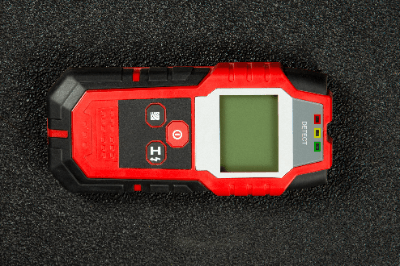What Is a Wall Scanner?
 A wall scanner is a measuring instrument that detects buried objects inside a wall.
A wall scanner is a measuring instrument that detects buried objects inside a wall.
The purpose of a wall scanner measurement is to determine the proper location for drilling holes in a wall or attaching an object to a wall. It is also referred to as a rebar scanner, a concrete detector, or a concrete sensor.
Objects buried inside walls can be rebar, steel, steel pipes, plastic pipes, wood, electric cables, and cavities. The appropriate wall scanner must be used for the purpose of detection.
Uses of Wall Scanners
Wall scanner applications are used for detecting objects inside walls in the construction and civil engineering field. Wall scanners are used to search the inside of walls, floors, and ceilings for water pipes, drainage pipes, conduit pipes, gas pipes, and so on.
Reinforcing steel, steel frames, piping, underlayment, reinforcement, spacing, cables, etc., are detected and unaffected areas are selected. Wall scanners are also used to survey the interior condition of walls and floors where railings, hardware, reinforcements, controls, operation panels, clocks, information equipment, shelving, etc. are to be installed.
When repairing plumbing and wiring, the role of the wall scanner is to identify the locations where they pass through to achieve efficient work. Wall scanner surveys can also be applied to investigate the condition of buried objects and voids on roads.
Principle of Wall Scanners
Wall scanners are mainly used with the electromagnetic radar method and the electromagnetic induction method.
1. Electromagnetic Radar Method
One of the characteristics of electromagnetic radar is that electromagnetic waves in the microwave band travel straight through a medium at a constant speed. They are reflected where different media come into contact with each other. Using this property, it is possible to detect the distance and position to that point. Measurement using electromagnetic radar is a nondestructive inspection. It is widely used because it does not use radiation.
In wall scanners using the electromagnetic radar method, electromagnetic waves are first emitted from an antenna onto a wall or floor. The returned electromagnetic waves are then received by the receiving antenna, and the distance is calculated from the time between the emission and the return. Location information can be obtained by moving the device with the built-in distance meter.
The relative permittivity, which is the ratio of the permittivity of a material to that of a vacuum, affects the speed of electromagnetic waves, and is typically 6 to 8 for common concrete. The relative permittivity also changes with moisture content, and concrete that has just been placed will have a higher permittivity. With electromagnetic radar, a higher frequency will produce a higher resolution and more accurate inspection, but a shallower measurable depth.
Normally, it is possible to measure up to 200 to 300 mm. Among buried objects, metals and non-metals can be distinguished by the waveform of the reflected electromagnetic waves. Since the relative permittivity of metal is higher than that of concrete, the upper part of the waveform becomes a white peak and the lower part a black peak.
2. Electromagnetic Induction Method
When an alternating current is applied to the test coil, a magnetic field is created and eddy currents are generated on the surface of the conductive material. The eddy currents induce the magnetic field in the opposite direction, causing a change in voltage, and the wall scanner using the electromagnetic induction method takes advantage of this change.
Cavities and PVC pipes cannot be measured by the electromagnetic induction method. The electromagnetic induction method is used to detect magnetic metals such as rebar and is used to measure the position and depth of rebar.
Some products can estimate the diameter of rebar. Depths of up to 100 mm can be measured.
How to Choose a Wall Scanner
Wall scanners should be selected based on the intended use, the type of structure, the type of object to be detected, and the depth to be detected. Types of structures include concrete, wood, block, brick, masonry, and wet concrete. The type of structures that can be detected is determined by the model of wall scanner.
Also, the types of objects that can be detected include metal pipes, non-metallic pipes, wood, and cavities. The detection depth sets the depth of detection from the surface of the wall or floor. It is important to select a model that can detect each of these.
Other Information on Wall Scanners
How to Use a Wall Scanner
Buried objects in walls are well detected if they are buried at right angles to the direction in which the wall scanner is moved. Therefore, if the object is a rod or line and is assumed to be buried vertically, scan the wall scanner horizontally.
If the buried object is expected to be horizontal, the wall scanner is moved vertically to detect it. If the object is expected to be a point shape, such as a screw, it is scanned both horizontally and vertically to locate the buried object.